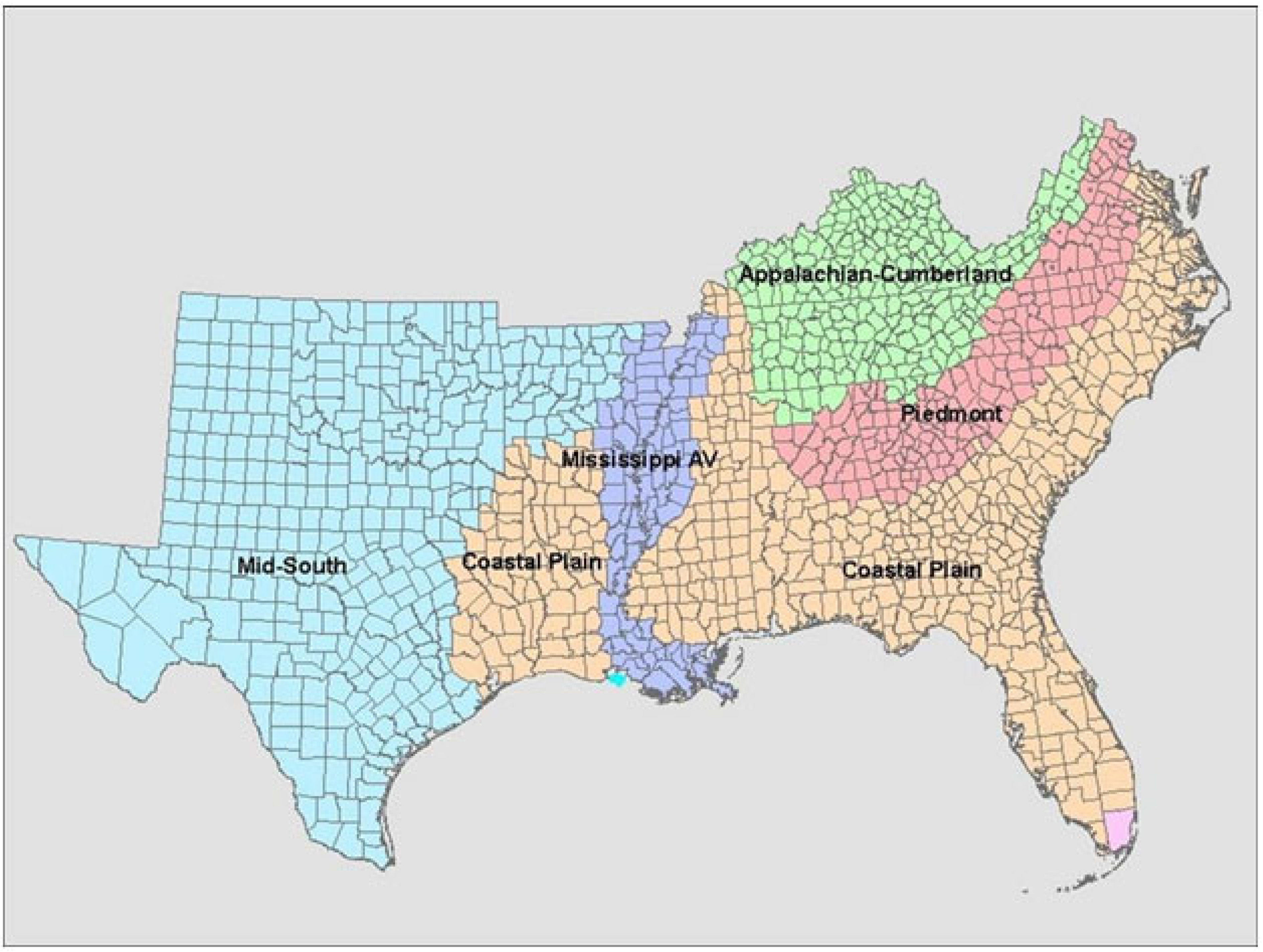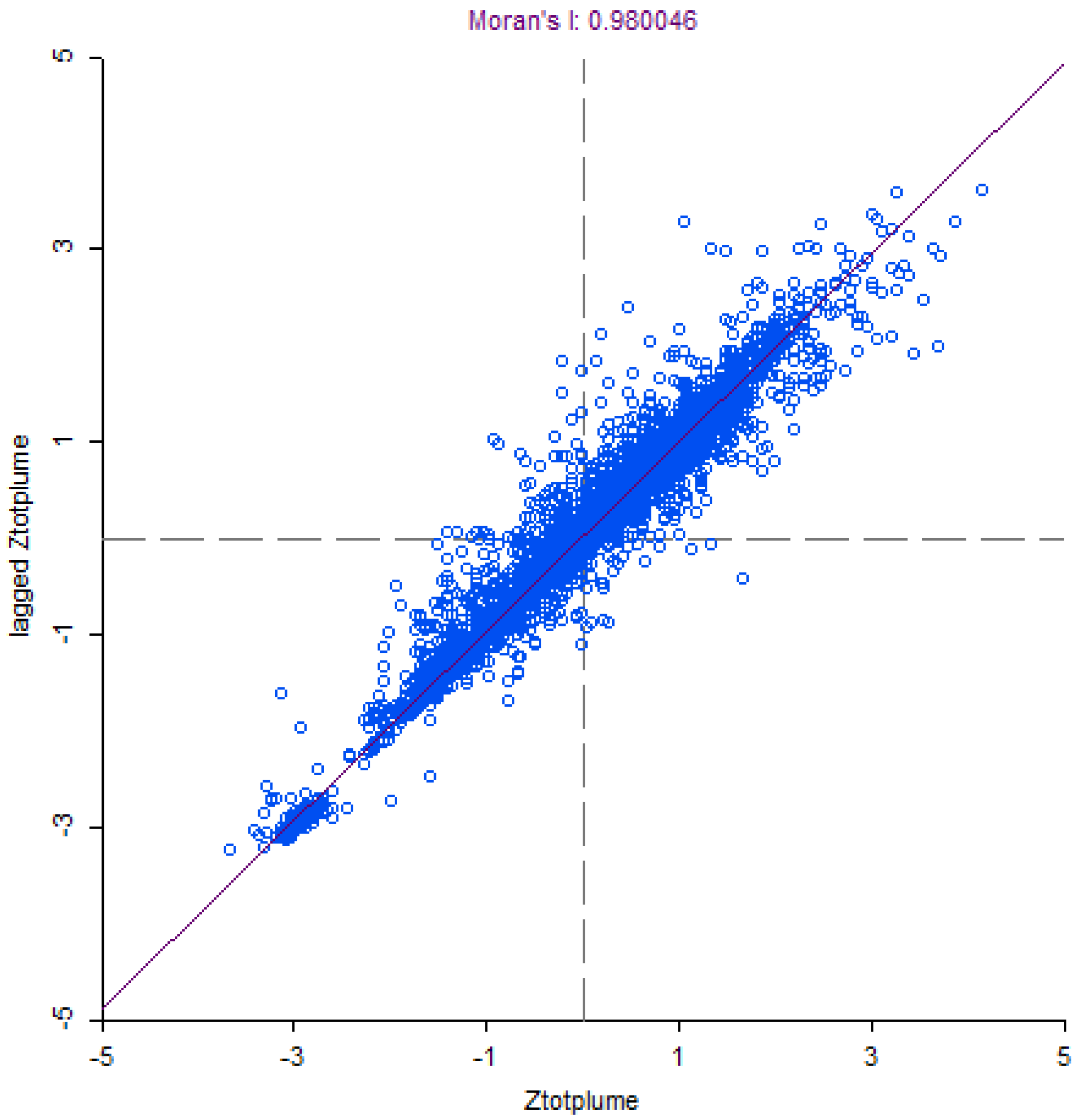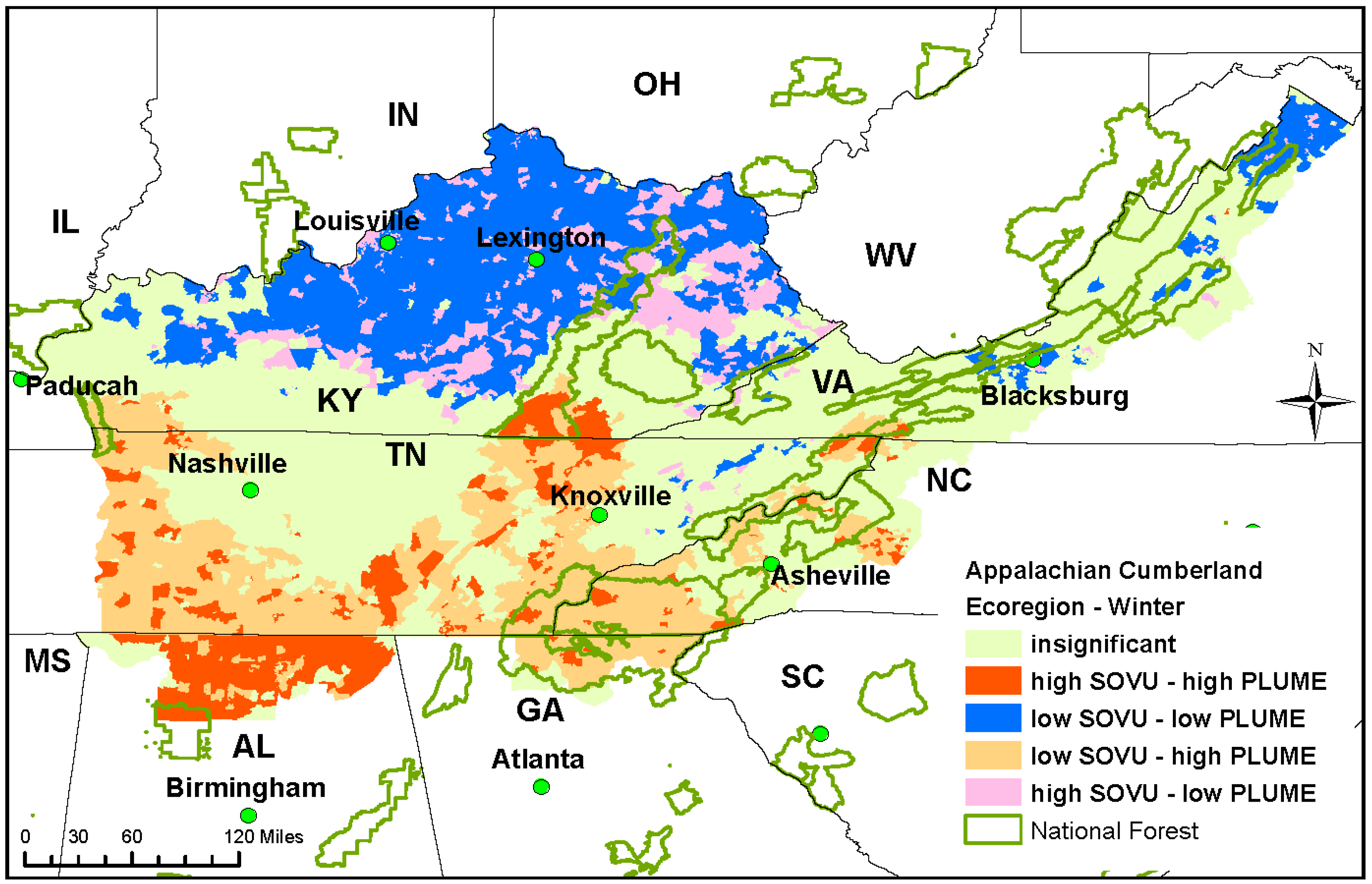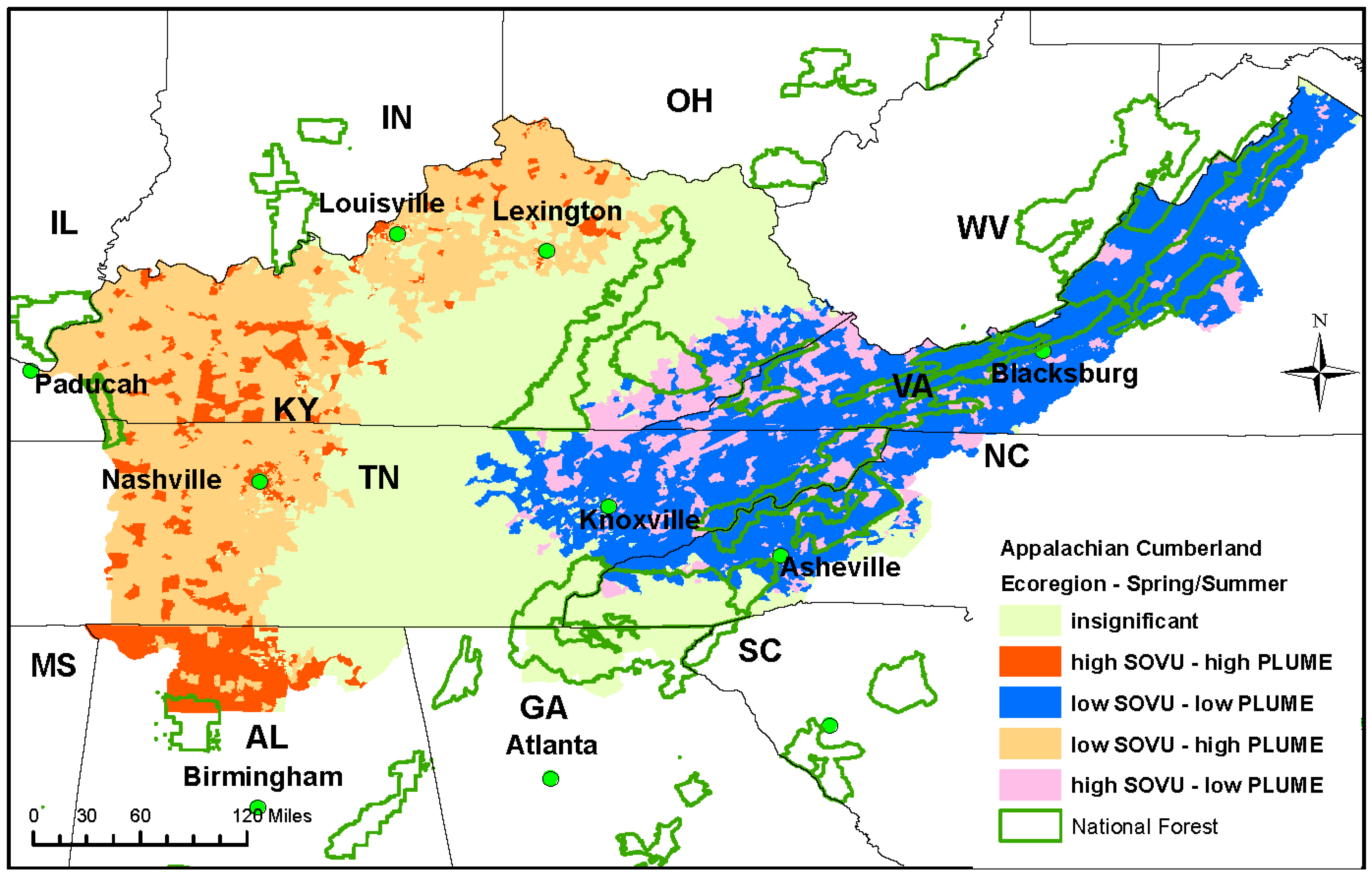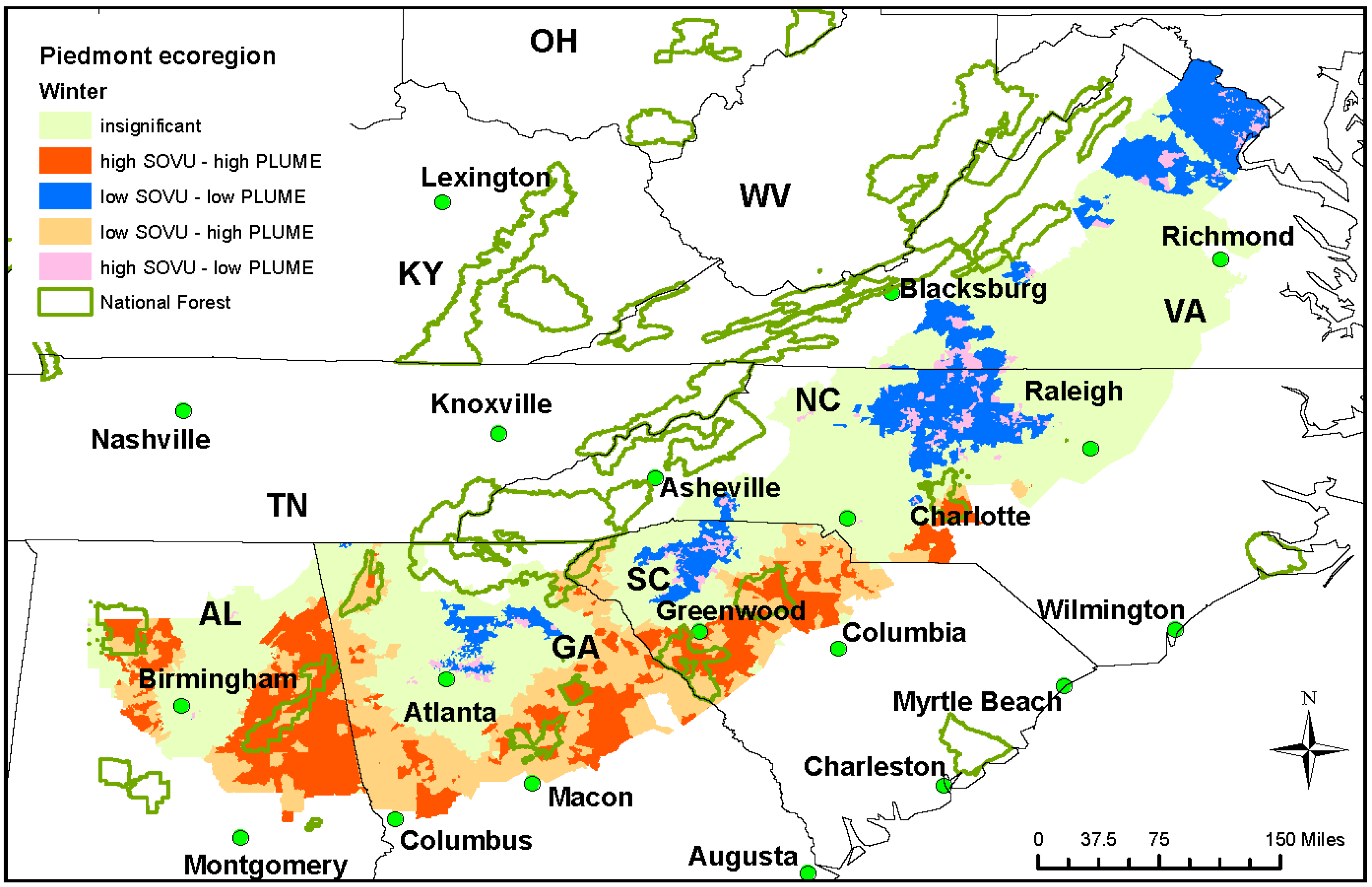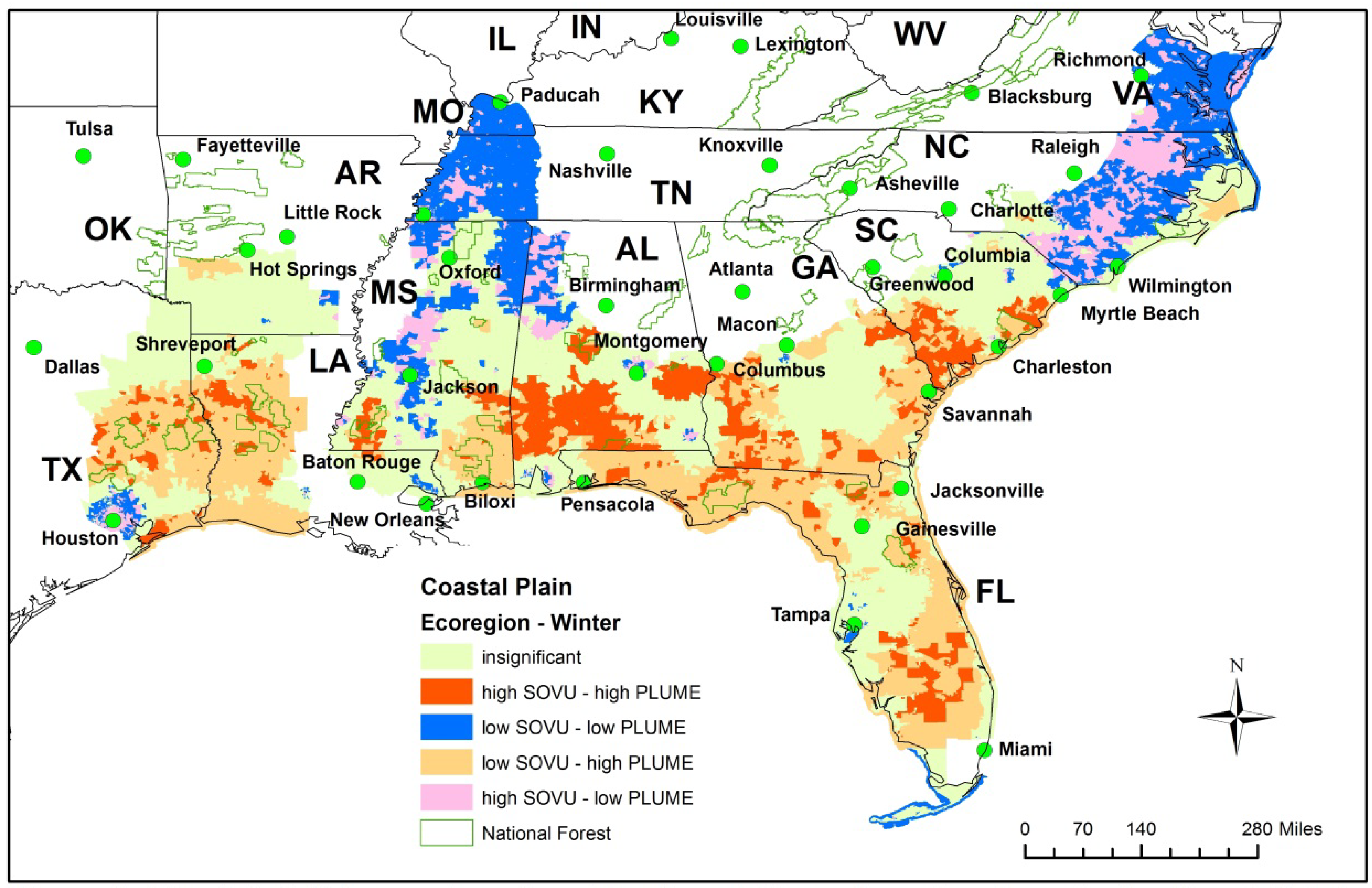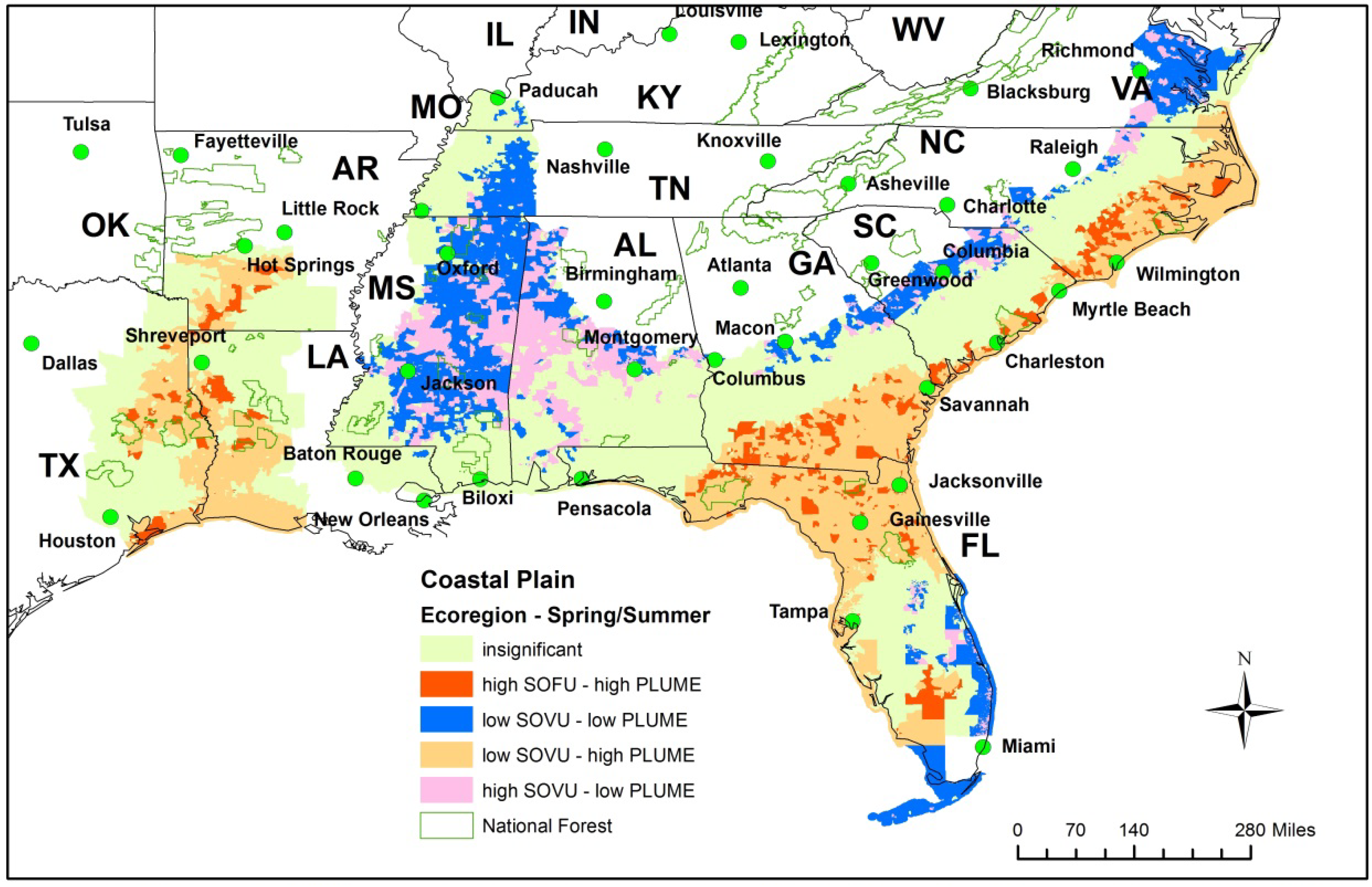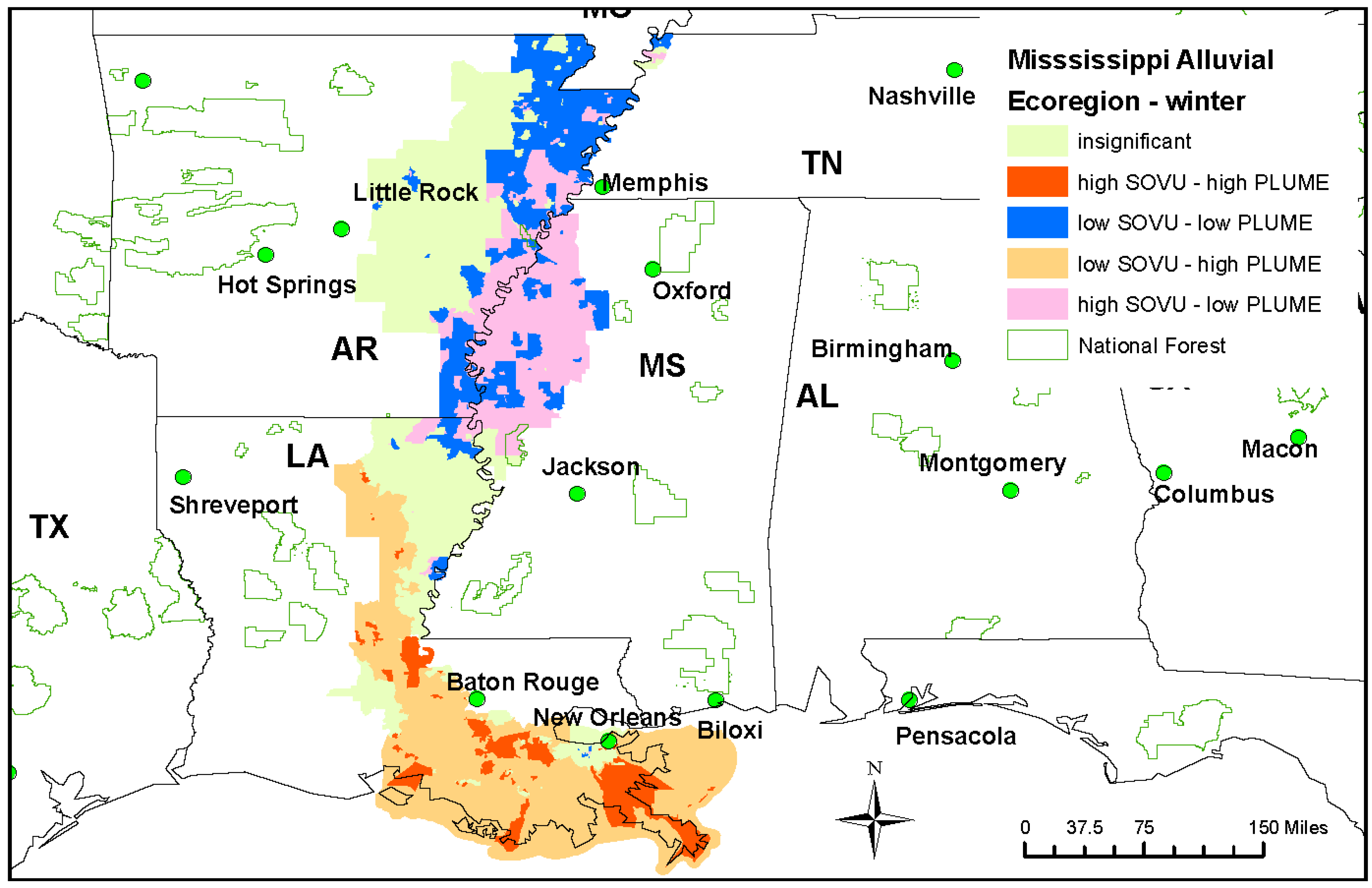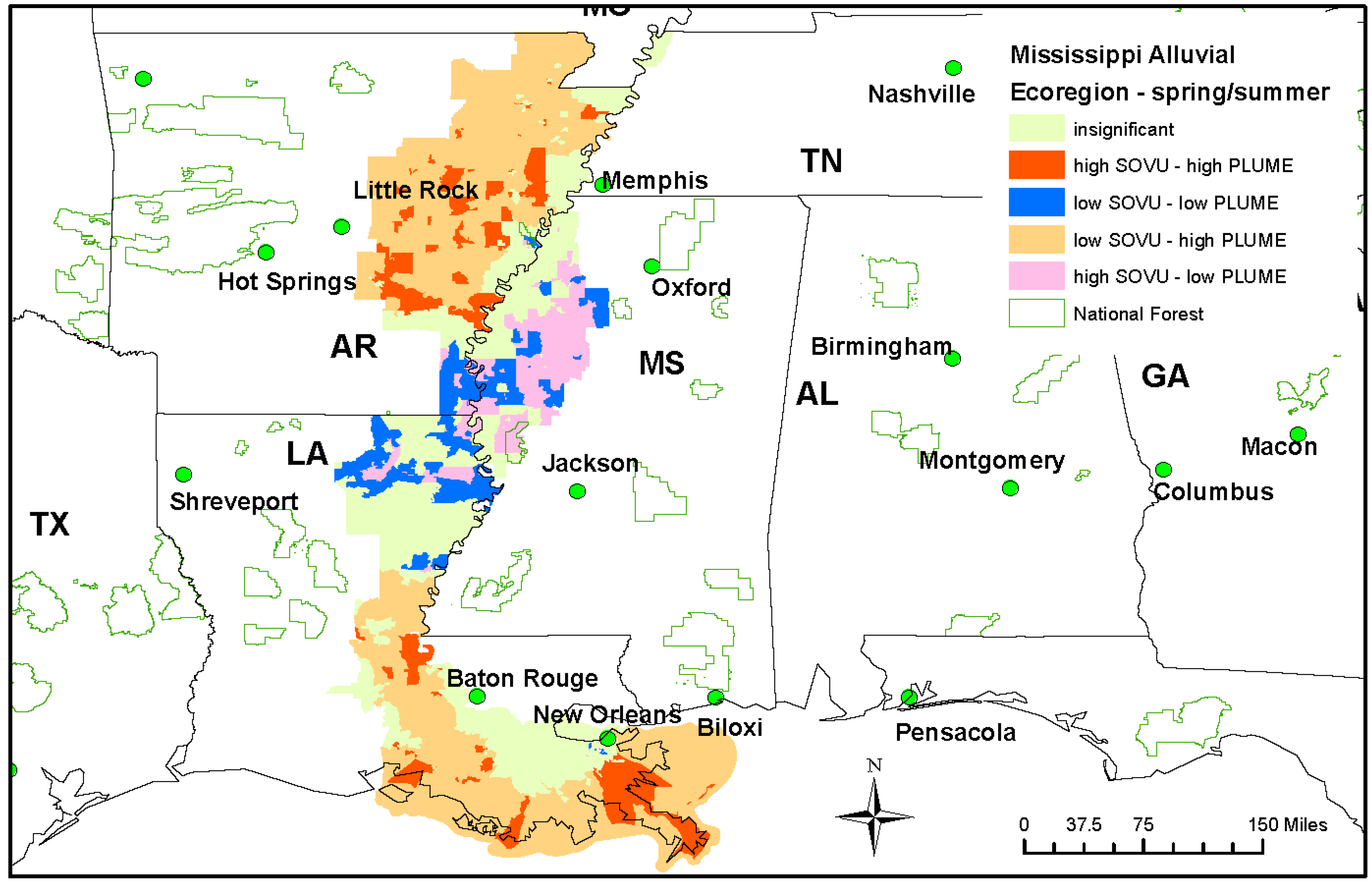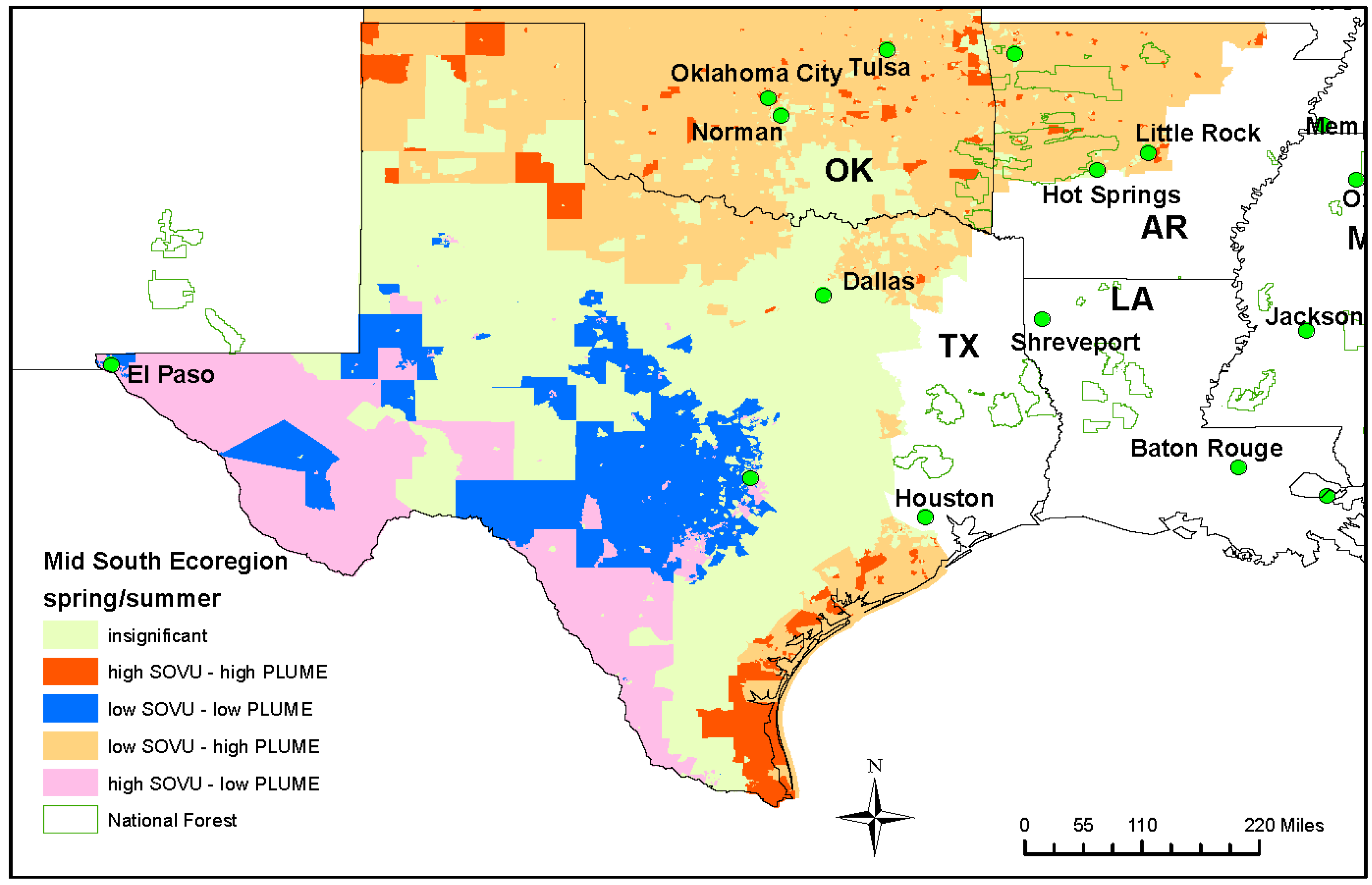4.2.1. Global Moran’s I and Univariate LISA
The ultimate aim of these analyses was to examine local-level, spatial associations between social vulnerability and the number of smoke plumes using Anselin’s [
35] local indicator of spatial association (LISA). Before identifying local clusters of bivariate, spatial association between SOVU and PLUME, we computed the Pearson’s correlation coefficient for the two variables under the assumption of data stationary. Results indicate little or no correlation across the ecoregions for either season (
Table 3). The strongest associations are for the spring/summer in the Mississippi-Alluvial and Mid-South and for the Mississippi-Alluvial, Coastal Plain, and Mid-South in winter, although the statistic indicates an inverse association. All correlations are highly significant, but this is likely due to the large sample sizes in each region. As well, global measures of association may obscure local clusters of positive association. Also, because these data represent the entire population, rather than a sample, we can assume all differences are actually significant. Keeping with the conventional reporting of values significant at
p ≤ 0.05, we present significance levels.
Next, we examined the association between SOVU and PLUME, again at the aggregate level, looking for an indication of spatial autocorrelation, using the global Moran’s I statistic (software GeoDaTM 1.6.61). Global Moran’s I is an indicator of aggregate spatial clustering (or dispersion). Values range between −1 (perfect dispersion) and +1 (perfect correlation). A value of zero indicates no spatial autocorrelation or a random spatial pattern.
Table 3 shows results very similar to those for the
r statistic for both the cooler and warmer months. All spatial analyses were conducted on
z-scores for SOVU and PLUME.
The univariate, global Moran’s I values were also computed for SOVU and PLUME, respectively. The univariate indicator provides a measure of how well a variable clusters (or disperses) with itself. In
Table 3, the values for SOVU across all regions suggest a considerable degree of spatial lag. In other words, we would expect to find either high socially vulnerable CBGs clustered together or low socially vulnerable clusters. The Moran’s I for PLUME shows near perfect autocorrelation for all regions in both seasons. To illustrate,
Figure 2 and
Figure 3 graph the global Moran’s I for SOVU (Mid-South) and PLUME (Mid-South spring/summer), respectively. In
Figure 2, observations graphed in the top right quadrant indicate that high SOVU values in a given CBG
i are surrounded by high SOVU values in neighboring CBGs; bottom left indicates that low SOVU observations in a CBG
i are surrounded by low SOVU values in neighboring CBGs. The two spatial outlier quadrants are the low/high quadrant (top left) and bottom right (high/low).
Table 3.
Pearson correlations and bivariate and univariate global Moran’s I for SOVU and PLUME by ecoregion and season of year.
Table 3.
Pearson correlations and bivariate and univariate global Moran’s I for SOVU and PLUME by ecoregion and season of year.
| Ecoregion | Pearson Correlation (r) | Bivariate Global Moran’s I (SOVU and PLUME) | Univariate Global Moran’s I (SOVU) | Univariate Global Moran’s I (PLUME) |
|---|
| Winter | Spring/Summer | Winter | Spring/Summer | Winter | Spring/Summer |
|---|
| Appalachian-Cumberland (n = 8404) | 0.06 *** | 0.08 *** | 0.07 | 0.09 | 0.59 | 0.91 | 1.00 |
| Piedmont (n = 12,103) | 0.06 *** | 0.19 *** | 0.07 | 0.20 | 0.65 | 0.94 | 0.99 |
| Coastal Plain (n = 28,806) | −0.14 *** | −0.13 *** | −0.13 | −0.13 | 0.63 | 0.93 | 0.98 |
| Mississippi Alluvial (n = 2492) | −0.24 *** | −0.32 *** | −0.23 | −0.30 | 0.54 | 0.92 | 0.92 |
| Mid-South (n = 16,248) | −0.14 *** | −0.26 *** | −0.13 | −0.25 | 0.69 | 0.92 | 0.98 |
Figure 2.
Global Moran’s I for SOVU.
Figure 2.
Global Moran’s I for SOVU.
Figure 3.
Global Moran’s I for PLUME.
Figure 3.
Global Moran’s I for PLUME.
4.2.2. LISA Bivariate Analysis
While Moran’s I indicates spatial clustering generally in the data, it does not reveal where this clustering appears across a study site. Again, a global statistic may conceal significant clustering. To determine how such clustering may manifest between two variables at the “local” level, we calculated the bivariate, local indicator of spatial association (LISA) statistic [
35]. The analysis is based on the First Law of Geography which assumes that all things in space are related, but those things closer in space are more strongly related [
30]. Therefore, we might expect certain social or biological/physical variables to cluster or hover together across space [
24]. The null hypothesis in LISA analysis assumes that there is no spatial autocorrelation between the two variables examined. In other words, the relationship between two variables is random. However, if the null is rejected, this indicates that the relationship is not random, and that there is just a small chance (depending on the
p-value) of obtaining the observed LISA statistic, if in the population the two variables are not co-located.
Spatial associations are based on clusters or the “neighborhood” of areal units adjacent to the areal unit of interest,
i (in our case CBGs). We specified the neighborhood of CBG
i based on a first order, queen contiguity weight matrix, which includes CBGs adjacent to CBG
i that shared a common border length or vertex. Bivariate LISA is calculated by the equation from Sunderlin [
30]:
where,
Il is the LISA statistic;
x is the SOVU value, and
y is the PLUME value for CBG
i and neighborhood
j, respectively. Similarly,
zx represents the standardized value for social vulnerability, and
zy represents the standardized value for number of smoke plumes. The variable w
ij is the weight matrix that defines CBGs comprising neighborhood
j (also generated using GeoDa™ 1.6.61). Because of difficulties in obtaining a LISA distribution, an
ad hoc distribution is created each time the LISA analysis is performed. This is done by permutation of LISA values a specified number of times (e.g., 99, 999, 9999). Critical values are then selected for pseudo-
p values. The LISA for a given CBG is compared with the critical value at a given significance level. For our analysis, significant clusters are those at the 0.05 level, with 999 permutations. Again,
p values are presented for illustrative purposes.
4.2.3. Sub-Regional Results of Bivariate Analysis
In
Figure 4,
Figure 5,
Figure 6,
Figure 7,
Figure 8,
Figure 9,
Figure 10,
Figure 11,
Figure 12 and
Figure 13, the LISA cluster mapping shows significant values for SOVU and PLUME grouped into four distinct clusters. These associations are described as either: high-high (high SOVU/high PLUME or “hot spots”); low-low (low SOVU/low PLUME or “cold spots”); low SOVU/high PLUME; or high SOVU/low PLUME. The low/high (green) and high/low (yellow) clusters are spatial outliers, meaning that the pattern is significant but the high and low values are intermixed. The high/low designation for each cluster (hotspot, coldspot, outlier) is determined by comparing the observed value of
x or
y for a given CBG with the average value of the respective variable for the entire study area (e.g., ecoregion [
35]. For example, a high/high cluster in the Piedmont region shows CBGs with a higher than Piedmont average SOVU value surrounded by CBGs with a higher than Piedmont average PLUME value. Similarly, a low/low cluster in the Mid-South indicates CBGs with a lower than Mid-South average SOVU value surrounded by CBGs with lower than Mid-South average PLUME values. CBG boundaries are not displayed in order to help presentation clarity.
Figure 4.
Bivariate LISA mapping of social vulnerability and smoke plume in the Appalachian-Cumberland ecoregion—winter.
Figure 4.
Bivariate LISA mapping of social vulnerability and smoke plume in the Appalachian-Cumberland ecoregion—winter.
Figure 5.
Bivariate LISA mapping of social vulnerability and smoke plume in the Appalachian-Cumberland ecoregion—spring/summer.
Figure 5.
Bivariate LISA mapping of social vulnerability and smoke plume in the Appalachian-Cumberland ecoregion—spring/summer.
Figure 6.
Bivariate LISA mapping of social vulnerability and smoke plume in the Piedmont ecoregion—winter.
Figure 6.
Bivariate LISA mapping of social vulnerability and smoke plume in the Piedmont ecoregion—winter.
Figure 7.
Bivariate LISA mapping of social vulnerability and smoke plume in the Piedmont ecoregion—spring/summer.
Figure 7.
Bivariate LISA mapping of social vulnerability and smoke plume in the Piedmont ecoregion—spring/summer.
Figure 8.
Bivariate LISA mapping of social vulnerability and smoke plume in the Coastal Plain ecoregion—winter.
Figure 8.
Bivariate LISA mapping of social vulnerability and smoke plume in the Coastal Plain ecoregion—winter.
Figure 9.
Bivariate LISA mapping of social vulnerability and smoke plume in the Coastal Plain ecoregion—spring/summer.
Figure 9.
Bivariate LISA mapping of social vulnerability and smoke plume in the Coastal Plain ecoregion—spring/summer.
Figure 10.
Bivariate LISA mapping of social vulnerability and smoke plume in the Mississippi-Alluvial ecoregion—winter.
Figure 10.
Bivariate LISA mapping of social vulnerability and smoke plume in the Mississippi-Alluvial ecoregion—winter.
Figure 11.
Bivariate LISA mapping of social vulnerability and smoke plume in the Mississippi-Alluvial ecoregion—spring/summer.
Figure 11.
Bivariate LISA mapping of social vulnerability and smoke plume in the Mississippi-Alluvial ecoregion—spring/summer.
Figure 12.
Bivariate LISA mapping of social vulnerability and smoke plume in the Mid-South ecoregion—winter.
Figure 12.
Bivariate LISA mapping of social vulnerability and smoke plume in the Mid-South ecoregion—winter.
Figure 13.
Bivariate LISA mapping of social vulnerability and smoke plume in the Mid-South ecoregion—spring/summer.
Figure 13.
Bivariate LISA mapping of social vulnerability and smoke plume in the Mid-South ecoregion—spring/summer.
Appalachian-Cumberland
The Appalachian-Cumberland ecoregion stretches from northern Virginia to western Kentucky, Tennessee, and north Alabama, covering an area of 99 million square miles.
Figure 4 and
Figure 5 illustrate bivariate LISA clusters for the Appalachian-Cumberland highlands. The winter month clusters (
Figure 4) show hot spots occurring in northern Alabama and in the 180 mile stretch between Knoxville and Nashville, TN. The William B. Bankhead National Forest (NF) in Alabama overlaps a portion of the hot spot. The Chattahoochee NF in north Georgia and the Cherokee NF just over the border in Tennessee overlap with both hot spots and outlier clusters at the Georgia-Tennessee line. Further to the northeast, hot spots can be seen near Asheville, NC, again overlapped by or proximal to National Forest lands (the Pisgah in North Carolina). There is also substantial intersection between the Daniel Boone NF in eastern Kentucky and hot spot clusters.
Hot and cold spots shift geographies in the spring and summer months, relative to the winter (
Figure 5). Hot spots are seen most clearly in the extreme western part of the Appalachian-Cumberland region in the warm season, and cold spots are in the central and northeastern most reaches of the ecoregion at this time. There is extensive overlap of cold spots with National Forests in the eastern Appalachian-Cumberland area but only small intersections in the western part of this ecoregion.
Piedmont
In the Piedmont during winter months, hot spots are evident in north Alabama (overlapping with the Talladega and Bankhead NFs), east and west of Birmingham. Hot spots are interspersed with low social vulnerability/high plume counts in Georgia in an area north of Macon and Columbus. Portions of the Chattahoochee-Oconee NF are proximal to these hot spots. In South Carolina, hot spots are clustered near Greenwood and in an area interspersed with low social vulnerability/high plume counts near the Sumpter NF. Hot spots also cluster southeast of Charlotte, NC, overlapping with the boundaries of the Uwharrie NF. Cold spots in winter months lie mostly to the north of hot spots throughout the Piedmont. A similar distribution of hot and cold spots is seen during the spring/summer season in the Piedmont, although there is a larger clustering of significant hot spots in Alabama. Also, hot spots appear just north of Raleigh, NC during the warmer season.
Coastal Plain
The Coastal Plain extends from southern Virginia, through Georgia and Alabama, and into Louisiana and east Texas—an area of more than 79 million square miles. In winter, hot spots converge to the north and south of Charleston, SC, and in a swath between Columbia, SC and Savannah, GA. The Francis Marion NF in South Carolina abuts hot spots in both winter and spring/summer. An inverted arc of hot spots and low/high clusters occur in South Georgia. Larger hot spot clusters congregate throughout south Alabama in winter. In terms of social vulnerability, hot spot clusters in this ecoregion are consistent with prior mappings of southern Black Belt counties and the concomitant generational poverty pervading some of these counties, particularly during the winter season [
36]. As expected, above average plume activity predominate in large areas of Florida in both winter and spring/summer. Hot spots also occur near the Ocala and Apalachicola, NF in Florida. Moving west,
Figure 8 shows hot spots interspersed with low/high clusters between Shreveport, LA and Houston, TX. In Louisiana, portions of the Kisatchie NF are interspersed with hot spots.
In warmer months, hot spot activity shifts to the extreme eastern part of the region, from eastern North Carolina down to an area south of Jacksonville, FL. Hot spot CBGs are also prominent in South Georgia, north central Florida and south Florida. Sporadic hot spot scatterings also appear in southern Louisiana up to an area below Hot Springs, AR. Large cold spot clusters occur east of Oxford, MS and Memphis, TN and east of Jackson, MS.
Mississippi Alluvial Valley
The Mississippi Alluvial Valley originates at the confluence of the Ohio and Mississippi Rivers in southern Illinois and runs to the Gulf of Mexico. In winter, hot spots occur near Baton Rouge and New Orleans, LA. Cold spots occur north of Jackson, MS up through Memphis, TN. In summer, hot spot activity is seen in the north and south of the region.
Mid-South
The Mid-South ecoregion covers most of Texas, all of Oklahoma and much of northwestern Arkansas. In winter, hot spot clusters are prominent in the south Texas. Hot spots are also seen in northwest Texas and in east Oklahoma and west Arkansas. The Ozark National Forest is proximal to some of the hot spot clusters in this part of the Mid-South. During the warmer months, hot spots are also in the very southern tip of Texas and are scattered throughout the northern part of the ecoregion.
In sum, the LISA analysis identified four significant clusters or associations between social vulnerability and plume dispersion across the South. While we did find “hot spots,” they do not characterize the relationship between these variables, overall. To help clarify this relationship,
Table 4 and
Table 5 show the distribution of association types in each region, by season. The majority of associations between social vulnerability and smoke plume are not significant at
p ≤ 0.05 in winter or in the Coastal Plain, Mississippi Alluvial, and Mid-South in spring/summer. In fact, the significant high/high associations accounted for no more than 8 percent of all associations in any ecoregion in winter (Appalachian Cumberland) and roughly 16 percent in spring/summer (Piedmont).
4.2.4. Plume Intensity in Hot Spots and Low/High Clusters
Next, we compared the intensity of plume exposure for hot spots and low/high smoke plume clusters by calculating the mean number of plumes for both cluster types. As well, we present the total number of clusters for both hot spots and low/high clusters. We also compared the mean number of plumes for hot spots and low/high clusters within one mile of a National Forest.
We compared hot spots and low/high clusters because these clusters controlled for smoke exposure. Both cluster types had “high” (above average) smoke exposure, only social vulnerability varied. The idea was to see if socially marginal clusters with high smoke exposure experienced more smoke compared to non-socially marginal populations with high smoke exposure in general and for clusters proximal to National Forests.
Table 4.
Distribution of LISA Clusters by Ecoregion—Winter.
Table 4.
Distribution of LISA Clusters by Ecoregion—Winter.
| Type of Association | Appalachian Cumberland (N = 8404) | Piedmont (N = 12,103) | Coastal Plain (N = 28,806) | Mississippi Alluvial (N = 2492) | Mid-South (N = 16,248) |
|---|
| | CBG (%) | CBG (%) | CBG (%) | CBG (%) | CBG (%) |
| High/High | 8.02 | 5.21 | 4.47 | 4.25 | 4.92 |
| Low/Low | 18.21 | 19.19 | 14.03 | 9.79 | 11.97 |
| Low/High | 10.57 | 5.34 | 8.60 | 12.96 | 10.85 |
| High/Low | 11.82 | 10.11 | 14.85 | 13.36 | 15.05 |
| Insignificant | 51.39 | 61.16 | 58.05 | 59.63 | 57.21 |
| Total | 100.00 | 100.00 | 100.00 | 100.00 | 100.00 |
Table 5.
Distribution of LISA Clusters by Ecoregion—Spring/Summer.
Table 5.
Distribution of LISA Clusters by Ecoregion—Spring/Summer.
| Type of Association | Appalachian Cumberland (N = 8404) | Piedmont (N = 12,103) | Coastal Plain (N = 28,806) | Mississippi Alluvial (N = 2492) | Mid-South (N = 16,248) |
|---|
| | CBG (%) | CBG (%) | CBG (%) | CBG (%) | CBG (%) |
| High/High | 14.16 | 15.62 | 4.90 | 4.49 | 7.82 |
| Low/Low | 20.59 | 19.74 | 13.38 | 6.22 | 8.40 |
| Low/High | 19.34 | 13.27 | 12.47 | 16.53 | 17.10 |
| High/Low | 11.17 | 7.53 | 10.94 | 9.87 | 12.60 |
| Insignificant | 34.76 | 43.84 | 57.24 | 62.88 | 54.07 |
| Total | 100.00 | 100.00 | 100.00 | 100.00 | 100.00 |
Table 6.
Mean plume count in hot spot and low/high clusters generally and within 1 mile of a National Forest. Number of hot spots and low/high clusters generally and within 1 mile of a National Forest—winter.
Table 6.
Mean plume count in hot spot and low/high clusters generally and within 1 mile of a National Forest. Number of hot spots and low/high clusters generally and within 1 mile of a National Forest—winter.
| Ecoregion | Mean Number of Plumes in Hot Spots | Mean Number of Plumes in Low/High Clusters | Number of Hot Spots | Number of Low/High Clusters | Mean Number of Plumes in hot Spots near National Forest | Mean Number of Plumes in Low/High Clusters near National Forests | Number of Hot Spots near National Forests | Number of Low/High clusters near National Forests |
|---|
| Appalachian Cumberland | 6.90 (s.d. = 3.48) | 6.32 (s.d. = 2.66) | 674 | 888 | 9.19 (s.d. = 7.55) | 8.19 (s.d. = 3.94) | 75 | 206 |
| Piedmont | 21.70 (s.d. = 11.86) | 21.91 (s.d. = 12.43) | 630 | 646 | 28.34 (s.d. = 16.10) | 26.81 (s.d. = 18.43) | 124 | 127 |
| Coastal Plain | 47.09 (s.d. = 21.93) | 50.98 (27.04) | 1255 | 2414 | 65.73 (s.d. = 33.72) | 71.28 (37.15) | 97 | 292 |
| Mississippi Alluvial | 23.31 (s.d. = 6.60) | 25.13 (s.d. = 8.18) | 106 | 323 | 0 | 0 | 0 | 0 |
| Mid-South | 21.80 (s.d. = 9.90) | 25.64 (s.d. = 12.74) | 799 | 1763 | 36.00 (s.d. = 15.59) | 40.61 (s.d. = 17.36) | 15 | 145 |
Table 7.
Mean plume county in hot spot and low/high clusters generally and within 1 mile of a National Forest. Number of hot spots and low/high clusters generally and within 1 mile of a National Forest—spring/summer.
Table 7.
Mean plume county in hot spot and low/high clusters generally and within 1 mile of a National Forest. Number of hot spots and low/high clusters generally and within 1 mile of a National Forest—spring/summer.
| Ecoregion | Mean Number of Plumes in Hot Spots | Mean Number of Plumes in Low/High Clusters | Number of Hot Spots | Number of Low/High Clusters | Mean Number of Plumes in Hot Spots near National Forest | Mean Number of Plumes in Low/High Clusters near National Forests | Number of Hot Spots near National Forests | Number of Low/High Clusters near National Forests |
|---|
| Appalachian Cumberland | 87.75 (s.d. = 4.23) | 87.92 (s.d. = 5.18) | 1190 | 1625 | 95.83 (s.d. = 2.97) | 99.38 (s.d.8.18) | 6 | 8 |
| Piedmont | 90.21 (s.d. = 4.92) | 91.49 (s.d. = 4.62) | 1891 | 1606 | 94.85 (s.d. = 7.90) | 93.54 (s.d. = 6.18) | 110 | 68 |
| Coastal Plain | 160.89 (s.d. = 22.60) | 162.05 (s.d. = 27.01) | 1411 | 3593 | 163.08 (s.d. = 23.25) | 164.22 (s.d. = 26.64) | 61 | 199 |
| Mississippi Alluvial | 136.90 (s.d. = 8.42) | 139.61 (s.d. = 9.56) | 112 | 412 | 0 | 135 | 0 | 1 |
| Mid-South | 140.24 (s.d. = 9.28) | 139.38 (s.d. = 8.93 | 1271 | 2778 | 135.80 (s.d. = 5.34) | 140.17 (s.d. = 6.39) | 10 | 138 |
Table 6 contains results for the winter season. Mean number of plumes was slightly higher in hot spots, compared to low/high areas for the Appalachian Cumberland ecoregion, in general, and for areas near National Forests in that ecoregion. Otherwise, hot spots were not more encumbered by smoke than other places across the South. Also, the number of hot spots near National Forests is either less than or equal (Mississippi-Alluvial) to the number of low/high clusters.
Table 7 also shows overwhelmingly that there is not more smoke exposure in hot spots vis-à-vis low/high clusters during the warmer months. Overall, results do not suggest that socially vulnerable populations are potentially exposed to more smoke plumes than populations that are not vulnerable in the terms we measured.
